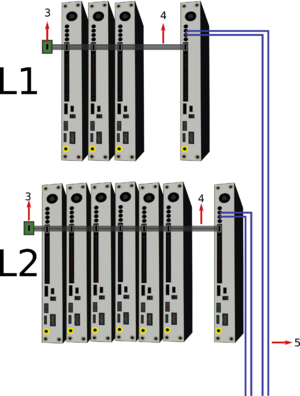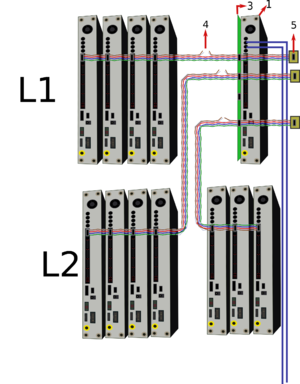Result June Integration Week
Here we are going to post some of the results achieved during the weeks to keep track of the developments.
Contents
Preliminary tests in synchronization[edit | edit source]
We run some tests on the synchronization and the situation seems promising, because the chip synchronizations seems OK and the other problems seem localized and understandable.
First of all we run a new acquisition with digital test pulses injected after cosmic triggers. The results are:
- The signals from the TIGER have the same time signature (Tcoarse) for each trigger.
- If a GEMROC has trouble with the clock distribution, it will not be in synchronous with the others (but its TIGERs are still in sync among each other)
- There can be some spurious trigger on the line (probably due to reflections). This causes the number of L1 counts to be not aligned anymore. We can look at the trigger arrival time "LOCAL L1 TIMESTAMP" to correctly put together the hits.
Moreover, we take a look at the run 58 inspecting the decoded file and notice that:
- All the TIGERs seems in synchronous in both L1 and L2
- The only sync problem was in GEMROC 6, which counted, in 5 seconds , 4 clock cycles more than the others (we already know from the 8b/10b errors on all its TIGERs that GEMROC 6 has some clock problem).
- Other anomalies come from the fact that the trigger period ranged during the acquisition from 380uS to 0us (less than we can measure) and then rising back up to ~10us. This is due to the meta-stability of the double timer used like pulse generator. When the triggers were very fast, multiple test pulses were generated in the same trigger window and sometimes the same events were correctly taken 2 times (because 2 very near trigger insisted on the same trigger window).
A confirmation of these results has been performed with the reconstructed run 125, 134 and 139:
- The synchronization within 1 clock is better than 95%
- The communication between 12 chip and the GEMROC is not properly working: 2 chip have known problem, the other 10 are under investigation
Summarizing[edit | edit source]
Good things:[edit | edit source]
- The chips synchronization seems very good
- The GEMROC seems capable to build packets at a very high trigger rate and to recover it's normal work flow even after an intense trigger burst
Bad things and proposed solutions[edit | edit source]
- We have some issue with the clock distribution (solution: the fan-out board that Angelo is finishing)
- We have some issue in trigger and check distribution (same as above)
- Double timer is not a reliable source of signals (the fan-out board will be able to generate them)
Bump in Time distribution[edit | edit source]
From the analysis of run 101-102 and run 107-108 it seems that the bump has disappeared. Need to check the configuration file to identify possible misconfiguration in the runs that may have caused/canceled the bump in the noise time distribution. It seems that the time peaking background is present in random trigger run only when the rate is bigger than 100 Hz. At 500 Hz the peak is present.
Mapping[edit | edit source]
A full review of the mapping of both L1 and L2 has been applied based on the indication from data taking.
Based on the anode connection, strip V on L1 and L2 were reversed on one side of the detector. Mapping of the strip X on L2 was reversed left-right.
Data analysis[edit | edit source]
The charge distribution of the hits is not under control: incongruence between run 134 and 139 are under investigation
Charge and time distributions are reasonable and it looks that we are extracting the proper signal from the events
Cluster size and cluster charge, if the threshold are low enough, are in agreement with the TB measurement with APV and TIGER
Effects of HV, induction field and threshold cut is understood and it is reasonable
Signal fan-out[edit | edit source]
Old system:[edit | edit source]
Before the IW, the signal are distributed as follow (see image):
- The clock were generated by two different master GEMROC, one for L1 and one for L2.
- Clock, check and trigger were distributed by the master board to the slave boards.
- Each line was terminated with an active termination, on totally handmade boards, at the end of the line (fare from the master powering it).
- Flat ribbon cables carried all the signal.
- The TRIGGER and CHECK signals incoming from the trigger setup arrived separately at L1 and L2.
New system:[edit | edit source]
After the IW, the system was updated as follow (see image):
- A modified GEMROC is used as FAN-OUT board for the whole system.
- Clock, trigger and check are now generated\received by this board and distributed coherently to the whole system, creating synchronization between L1 and L2.
- A connection board is attached to the fan out board, to interface the device from the rear ports to the fast signal cables.
- Twisted cables are used instead of flat one, to ensure better differential signal compensation.
- The terminators are now placed near the FAN-OUT board, which power them. The power cable are severed between the fan-out board and the others.
- The differential impedance of the terminators was finally tuned. Now is set around 200 Ohms.
- The distributed clock frequency is lowered at 10MHz and then the input PLLs in the GEMROCs recover it to the working value of 40MHz.

